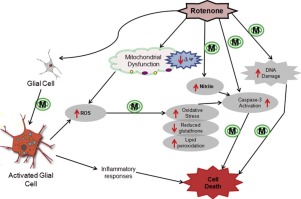NeuroToxicology ( IF 3.4 ) Pub Date : 2018-01-31 , DOI: 10.1016/j.neuro.2018.01.006 Dinesh Kumar Verma , Dhirendra Kumar Singh , Sonam Gupta , Parul Gupta , Abhishek Singh , Joyshree Biswas , Sarika Singh

|
The study was conducted to evaluate the effect of minocycline against pesticide rotenone induced adverse effects in different rat brain regions. Assessment of oxidative stress, nitrite levels, degenerating neurons and level of cleaved caspase-3 was done in frontal cortex, mid brain, hippocampus and striatum regions of rat brain. In addition the expression profile of neuronal (MAP2), astrocytes (GFAP) and microglia (cd11b) markers was done after treatments. Rotenone induced DNA fragmentation was also assessed in all studied rat brain regions by utilizing comet assay. Rotenone administration caused significantly decreased level of glutathione along with increased level of nitrite and lipid peroxidation. Significant oxidative and nitrosative stress was also observed after rotenone administration which was considerably inhibited in minocycline treated rats in time dependent manner. Fluorojade staining and levels of cleaved caspase 3 showed the degeneration of neurons and apoptosis respectively in studied rat brain regions which were further inhibited with minocycline treatment. Rotenone administration caused significantly increased reactivity of astrocytes, microglia and altered neuronal morphology in rat brain regions which was also partially restored with minocycline treatment. In conclusion, present study showed that minocycline treatment attenuated the rotenone induced oxidative stress, nitrite level, degeneration of neurons, augmented glial reactivity and apoptosis.
中文翻译:

米诺环素通过抑制细胞凋亡,亚硝酸盐水平和氧化应激来减少鱼藤酮诱导的神经毒性和神经胶质激活
进行该研究以评估米诺环素对农药鱼藤酮所致的不同大鼠脑区域的不良影响。在大鼠大脑的额叶皮层,中脑,海马和纹状体区域评估氧化应激,亚硝酸盐水平,退化的神经元和裂解的caspase-3水平。此外,在治疗后进行神经元(MAP2),星形胶质细胞(GFAP)和小胶质细胞(cd11b)标记的表达谱。还利用彗星试验在所有研究的大鼠脑区域中评估了鱼藤酮诱导的DNA片段化。鱼藤酮的施用导致谷胱甘肽水平显着降低,亚硝酸盐和脂质过氧化水平升高。鱼藤酮给药后还观察到明显的氧化和亚硝化应激,其在米诺环素处理的大鼠中以时间依赖性方式被显着抑制。荧光染料染色和半胱氨酸天冬氨酸蛋白酶3的切割水平分别显示了研究的大鼠脑区域中神经元的变性和凋亡,它们被米诺环素处理进一步抑制。注射鱼藤酮会导致大鼠脑区域星形胶质细胞,小胶质细胞的反应性显着增加,并且神经元形态发生改变,而米诺环素治疗也能部分恢复这种状态。总之,本研究表明,米诺环素治疗可减轻鱼藤酮诱导的氧化应激,亚硝酸盐水平,神经元变性,神经胶质反应性增强和细胞凋亡。荧光染料染色和半胱氨酸天冬氨酸蛋白酶3的切割水平分别显示了研究的大鼠脑区域中神经元的变性和凋亡,它们被米诺环素处理进一步抑制。注射鱼藤酮会导致大鼠脑区域星形胶质细胞,小胶质细胞的反应性显着增加,并且神经元形态发生改变,而米诺环素治疗也能部分恢复这种状态。总之,本研究表明,米诺环素治疗可减轻鱼藤酮诱导的氧化应激,亚硝酸盐水平,神经元变性,神经胶质反应性增强和细胞凋亡。荧光染料染色和半胱氨酸天冬氨酸蛋白酶3的切割水平分别显示了研究的大鼠脑区域中神经元的变性和凋亡,它们被米诺环素处理进一步抑制。注射鱼藤酮会导致大鼠脑区域星形胶质细胞,小胶质细胞的反应性显着提高,并且神经元形态发生改变,而米诺环素治疗也能部分恢复这种状态。总之,本研究表明,米诺环素治疗可减轻鱼藤酮诱导的氧化应激,亚硝酸盐水平,神经元变性,神经胶质反应性增强和细胞凋亡。小胶质细胞和大鼠大脑区域神经元形态的改变,米诺环素治疗也可以部分恢复这种形态。总之,本研究表明,米诺环素治疗可减轻鱼藤酮诱导的氧化应激,亚硝酸盐水平,神经元变性,神经胶质反应性增强和细胞凋亡。小胶质细胞和大鼠大脑区域神经元形态的改变,米诺环素治疗也可以部分恢复这种形态。总之,本研究表明,米诺环素治疗可减轻鱼藤酮诱导的氧化应激,亚硝酸盐水平,神经元变性,神经胶质反应性增强和细胞凋亡。



























 京公网安备 11010802027423号
京公网安备 11010802027423号